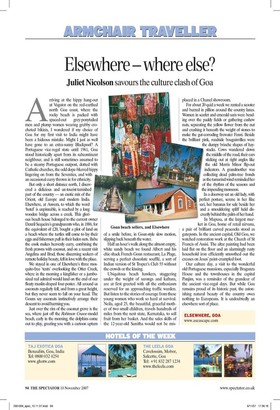Elsewhere — where else?
Juliet Nicolson savours the culture clash of Goa Arriving at the hippy hang-out at Vagator on the red-earthed north Goa coast, where the rocky beach is packed with spaced-out grey-ponytailed men and plump women wearing grubby crocheted bikinis, I wondered if my choice of Goa for my first visit to India might have been a hideous mistake. Might I just as well have gone to an extra-sunny Blackpool? A Portuguese vice-regal state until 1961, Goa stood historically apart from its subcontinent neighbour, and is still sometimes assumed to be a steamy Portuguese outpost, dotted with Catholic churches, the odd dope-blurred hippy lingering on from the Seventies, and with an occasional curry thrown in for ethnicity.
But only a short distance north, I discovered a delicious and un-tourist-tarnished part of the country — an exotic mix of the Orient, old Europe and modem India.
Elsewhere, at Aswem, to which the word 'hotel' is unpinnable, is reached by a long wooden bridge across a creek. This glorious beach house belonged to the current owner Denzil Sequeira's grandparents who, in 1886, for the equivalent of £20, bought a plot of land on a beach where the turtles still come to lay their eggs and fishermen pull in their laden nets. Babu the cook makes heavenly curry, combining the fresh prawns with coconut, and on a recent visit Angelina and Brad, those discerning seekers of remote holiday beauty, fell in love with the place.
We stayed in one of Elsewhere's three mosquito-free 'tents' overlooking the Otter Creek, where in the morning a kingfisher or a jumbosized red admiral would land on the end of our floaty muslin-draped four-poster. All around us coconuts regularly fell, and from a great height, but they never seem to fall on your head. The Goans say coconuts instinctively arrange their descent to avoid harming you.
Just over the rim of the coconut grove is the sea, where just off the Robinson Cnisoe-model beach, early in the morning, the dolphins come out to play, greeting you with a cartoon upturn of a smile before, in Goan-style slow motion, slipping back beneath the water.
Half an hour's walk along the almost empty, white sandy beach we found Albert and his chic-shack French-Goan restaurant, La Plage, serving a perfect chocolate soufflé, a sort of Indian version of St Tropez's Club 55 without the crowds or the kissing.
Ubiquitous beach hawkers, staggering under the weight of sarongs and kaftans, are at first greeted with all the enthusiasm reserved for an approaching traffic warden. But listen to the stories of courage from these young women who work so hard at survival. Neila, aged 25, the beautiful, graceful mother of two small children, travels hundreds of miles from the next state, Karnataka, to sell fruit from her basket. And the sales skills of the 12-year-old Sunitha would not be misplaced in a Chanel showroom.
For about 20 quid a week we rented a scooter and buzzed in pillion around the country lanes. Women in scarlet and emerald saris were bending over the paddy fields or gathering cashew nuts, separating the yellow flower from the nut and crushing it beneath the weight of stones to make the gut-corroding firewater Fermi. Beside the brilliant pink roadside bougainvillea were the dumpy brioche shapes of haystacks. Cows wandered down the middle of the road, their ears sticking out at right angles like the old Morris Minor flip-out indicators. A grandmother was collecting dead palm-tree fronds as the tamarind wind reminded her of the rhythm of the seasons and the impending monsoon.
In a doorway sat an old lady, with perfect posture, serene in her lilac sari, her bananas for sale beside her and a smouldering spliff held discreetly behind the palm of her hand.
In Mapusa, at the largest market in Goa, home of retail nirvana, a pair of brilliant carved peacocks stood as gateposts. In the ancient capital, Old Goa, we watched restoration work at the Church of St Francis of Assisi. The altar painting had been laid flat on the floor and an alarmingly rusty household iron efficiently smoothed out the creases on Jesus' paint-crumpled foot.
Our culture day, a visit to the wonderful old Portuguese mansions, especially Braganza House and the townhouses in the capital Panjim, was a reminder of the grandeur of the ancient vice-regal days. But while Goa remains proud of its historic past, the astonishing natural beauty of the country owes nothing to Europeans. It is undoubtedly an elsewhere sort of place.
ELSEWHERE, GOA www.aseascape.com





































































 Previous page
Previous page